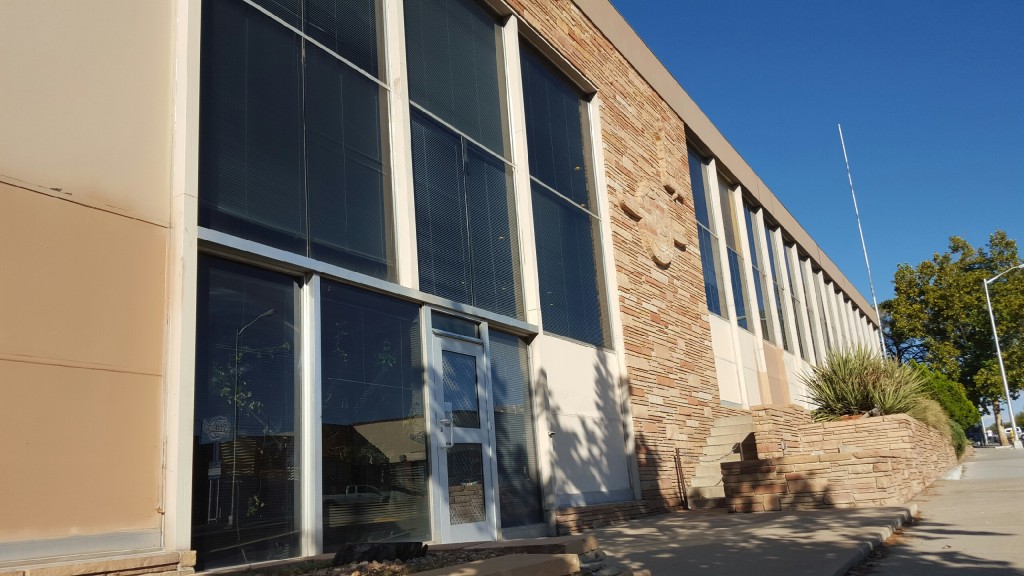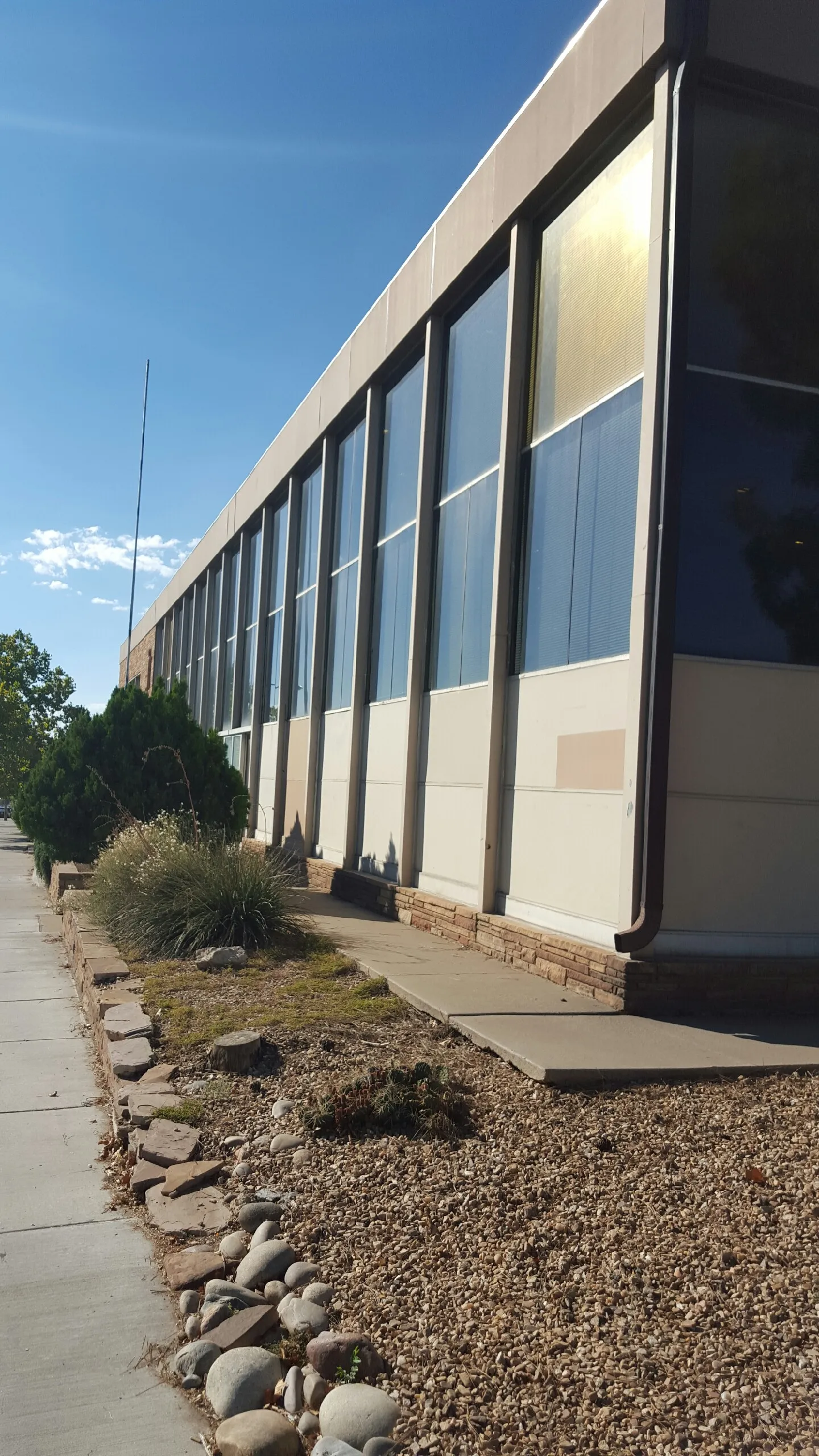1948-55
William Burk, Jr.
Case study by:
Ryan Morton,Fri Oct 09 2015
Galles Motor Company

Introduction
The Galles Motor Company dealership, located at 131 Pine Street SE on the north side of Albuquerque’s major spine, Central Avenue, was built in the early 1950s, a time when the automobile was becoming central to American culture. The Galles family had lived in Albuquerque for close to a century when they constructed this new location to sell Cadillacs and Oldsmobiles, just west of the University of New Mexico. Local architect William Burk, Jr. designed the new building during an era when modernism was sweeping through the growing metropolis of Albuquerque. With its location on historic Route 66 and its dramatic glass and stone façade, the new dealership acted as a billboard for the automobile in mid-century Albuquerque. Today, it continues to serve as a reminder of the fundamental role that the car played in the postwar development of the city.
Context
The Galles family first made their impact on Albuquerque in the mid-19th century. Nicholas Galles was the first of his family to inhabit the New Mexico Territory, where he opened a wagon repair shop. The business continued until H.R. Galles brought the first automobile to Albuquerque in 1908. The popularity of his automobile encouraged Galles to bring and sell the first eleven cars in the city, marking the birth of the Galles Motor Company.1 Years later, in 1933, the family obtained a franchise with Chevrolet, growing their successful car business. After this success, they joined with the Groesbeek family to form Galles Groesbeek, another step in their wildly successful endeavor. Eventually, Galles franchised both Cadillac and Oldsmobile and built a showroom and service bay close to the corner of Central and University.2 This building marked a key moment in the company’s history, as it maintained its decades-long role as one of the city’s major automobile retailers. Though at different locations today, the family continues to thrive selling Chevrolet automobiles in Albuquerque, where the cars they originally brought here have shaped the local culture in profound ways.
The Galles Motor Company’s Cadillac and Oldsmobile building rose at the center of Central Avenue, then part of Route 66, a street that was filled with life and attraction at the time. In the immediate postwar period, the car was becoming a necessary staple as the city of Albuquerque continued to expand rapidly in both population and land area. People were coming home from war in these years, subdivisions were popping up to house them, cities were growing, and people needed cars to navigate them. Likewise, car design was becoming increasingly more stylish, and technological developments improved both production quality and the ease of manufacture. More than a means of transportation, the automobile – which represented ideals of freedom and endless possibilities – came to drive and transform American culture. The car served as a status symbol, an attraction, and a necessary part of the American Dream.
At the same time, architecture itself was experiencing profound transformation, as the modern movement reached its ascendancy. As a city very much in its prime in the postwar era, Albuquerque became the site of scores of new buildings that represented modernism’s ideals of technological progress, material and spatial experimentation, and social change. Architects such as Max Flatow, John Gaw Meem and William Burk, Jr., who all worked in the modern language to varying extents, were occupied with designing some of the most influential buildings in Albuquerque. These mid-century decades would mark a new opportunity for the Galles family, who expanded their role in the city. Their new venture on Central required an architectural statement that matched the technological progress and newfound potential they sold to customers as an automobile powerhouse.
For their new Cadillac and Oldsmobile dealership in the Central and University area, Galles turned to Burk, who had established his reputation as one of the earliest modernists in Albuquerque even before World War II. The dealers intended this new location to be an attraction in the city, a destination.3 Cadillac and Oldsmobile cars were among the most luxurious models in the Chevrolet family; the goal of the building was clearly to reflect this luxury and showcase the state-of-the-art cars within, shown through the sleek south elevation facing Central Avenue.
Plan
Galles’s new dealership most likely reached its final form sometime after 1955, with design beginning late in the 1940s or early in the new decade. Official construction documents are dated August 22, 1954 and revisions to the structure are dated January 1955. In plan, William Burk, Jr.’s design followed a reverse L-shaped form that incorporated both a sales department and a service garage. The sales department aligned against Central Ave. on the east-west axis. The service garages formed the long part of the L on the north-south axis.4
Elevations
Burk designed the southern façade with long brick-like Arizona Stone and a very large glass curtain wall. The glass curtain wall let an immense amount of natural light into the showroom, a crucial element for showcasing cars. This was the building’s way of attracting customers and announcing the presence of the automobile. The façade acted as a billboard and was badged with the Cadillac and Oldsmobile symbols, subtly articulated in low relief in Arizona Stone.5 Passersby could peer through the transparent façade and see the luxury automobiles spinning in the showroom. The sophisticated and boldly modernist south elevation reflected the company’s newly franchised luxury automobiles, available for sale within.
The service bay section of the building was less detailed and more functional. This wing contained the tire shop and service area as well as other service garages. The eastern façade claimed a material palette that matched this utilitarian purpose. Burk’s design utilized white concrete masonry units, a material that was much cheaper than the Arizona Stone of the southern elevation.6 This material distinction between the east and south façades contributed to the honest articulation of the building’s different functions.
Present and Future
Today the Galles Motor Company building is owned by the University of New Mexico, and occupied by the university’s Advanced Computations Department. UNM purchased the building roughly 20 years ago, as Galles decamped to a new location at Lomas and University Boulevards. Over time, the building’s new owners have dimmed its most distinct features, especially its glass façade, leading to an inconspicuous presence in the area. The building is now secure and one may not enter without checking in and having a member of the department as an escort. Nonetheless, the showroom remains largely intact, with the original mezzanine railing present. Instead of automobiles, the space of the showroom now holds cubicles for UNM staff. The service bay now houses the department’s computer needs. The exterior continues to hold the Cadillac and Oldsmobile badging on its southern facade, however, reminding passersby of its previous incarnation.
UNM will potentially seek to demolish the original Galles building in the next few years, due to its lack of practical function for university use and operational costs. UNM’s Center for Advanced Research Computing will relocate to another building, likely on campus. Since Central and University is a major intersection, UNM hopes to sell the land or create something that will bring in revenue and enhance the overall environment. Performance is another major driving force behind the potential demolition of the building. The fully glazed south elevation lets an excessive amount of heat into the building. When walking in you can feel the heat immediately, especially walking up the stairs towards the original Galles office. The current inhabitants of the building have covered up many of the windows in an attempt to manage the heat issue. This type of environment is not ideal for a building that houses several hundred computers and super computers, as they are generating their own heat, yet such modifications have reduced the building’s strongest architectural statement. Air conditioning to maintain the interior climate results in a large cost to the University. As of late 2015, the department noted that the building will most likely not survive another two years.
The Galles Motor Company building celebrates a time when the automobile dominated American culture. The attention to style and detail here shows the consideration given to automobiles in the postwar era, as Albuquerque expanded tremendously and became a modern city. The Galles family has been a highly recognized name in Albuquerque history for the past century and a half, especially to those who purchased their first vehicle from this location. Galles Motor Company continues to thrive, operating several car dealerships in New Mexico. While the family’s future remains promising, however, the building that once helped Galles dominate the automobile business is likely on the verge of demolition.
Footnotes
-
Andrew Webb, “Galles Has Seen a Lot of Change Since Founding in 1908,” Albuquerque Journal, 11 March 2006; “About Us,” Galles Chevrolet, accessed September 20, 2015, http://www.galleschevy.com/aboutus.aspx. ↩
-
“Your Future At Galles Chevrolet,” ca. mid-1960s, Box 1, Folder 1, Ward Hicks Advertising Printing Samples (MSS 411 BC), Center for Southwest Research and Special Collections, University of New Mexico, Albuquerque, NM. ↩
-
Abra Altman, interview by author, Albuquerque, NM, 1 October 2015. ↩
-
William Burk, Jr., Ground Floor Plan, Galles Motor Company, Collection of Center for Advanced Research Computing, University of New Mexico, Albuquerque, NM (hereafter Collection of Center for Advanced Research Computing). ↩
-
Burk, Jr., South Elevation, Collection of Center for Advanced Research Computing. ↩
-
Burk, Jr., East Elevation, Collection of Center for Advanced Research Computing. ↩



